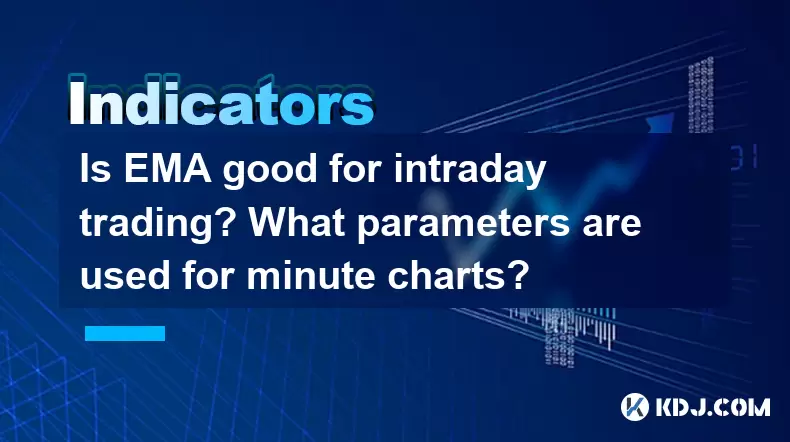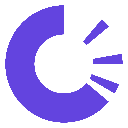-
 bitcoin
bitcoin $118548.520763 USD
3.67% -
 ethereum
ethereum $4352.564943 USD
4.79% -
 xrp
xrp $2.964058 USD
4.22% -
 tether
tether $1.000565 USD
0.05% -
 bnb
bnb $1028.372955 USD
1.46% -
 solana
solana $221.373507 USD
6.00% -
 usd-coin
usd-coin $0.999933 USD
0.02% -
 dogecoin
dogecoin $0.248633 USD
6.85% -
 tron
tron $0.341444 USD
2.38% -
 cardano
cardano $0.852946 USD
5.82% -
 hyperliquid
hyperliquid $47.869306 USD
6.15% -
 chainlink
chainlink $22.561476 USD
6.01% -
 ethena-usde
ethena-usde $1.001258 USD
0.05% -
 avalanche
avalanche $30.660000 USD
2.06% -
 stellar
stellar $0.400917 USD
9.76%
Is EMA good for intraday trading? What parameters are used for minute charts?
EMA is key in intraday trading, reacting quickly to price changes; common settings are 5, 10, 20, and 50 minutes for capturing short-term trends and reversals.
May 22, 2025 at 07:00 am

Understanding EMA and Its Role in Intraday Trading
The Exponential Moving Average (EMA) is a popular technical indicator used by traders to identify trends and potential entry and exit points in the market. In the context of intraday trading, where positions are opened and closed within the same trading day, the EMA can be particularly useful. The primary advantage of using the EMA for intraday trading is its ability to react quickly to price changes, making it more responsive than the Simple Moving Average (SMA).
Traders often use the EMA to determine the direction of the market and to find potential points where the market might reverse. For intraday trading, shorter time frames are typically used, and the EMA can help traders make quick decisions based on recent price movements. The key to using the EMA effectively in intraday trading lies in selecting the right parameters for the specific market conditions and trading style.
Parameters for Minute Charts in Intraday Trading
When it comes to setting up the EMA for minute charts in intraday trading, the choice of parameters is crucial. Commonly used parameters for minute charts include 5, 10, 20, and 50 EMAs. These parameters help traders capture short-term trends and potential reversals within the trading day.
- 5-minute EMA: This is extremely sensitive and can help traders identify very short-term trends. It is useful for scalping strategies where traders aim to make quick profits from small price movements.
- 10-minute EMA: This provides a slightly longer-term view and is often used to confirm trends identified by the 5-minute EMA. It can help traders stay in trades a bit longer and capture larger price movements.
- 20-minute EMA: This is useful for identifying medium-term trends within the trading day. It can help traders filter out noise and focus on more significant price movements.
- 50-minute EMA: This is used to identify longer-term trends within the intraday session. It can be particularly useful for traders who aim to hold positions for a few hours rather than minutes.
Setting Up EMA on Trading Platforms
To set up the EMA on a trading platform, follow these steps:
- Choose your trading platform: Most platforms, such as MetaTrader 4 or 5, TradingView, or Thinkorswim, support the EMA indicator.
- Navigate to the indicators menu: This is usually found under the 'Insert' or 'Indicators' tab.
- Select the EMA: Look for the Exponential Moving Average in the list of available indicators.
- Set the parameters: Input the desired periods (e.g., 5, 10, 20, 50) and adjust any other settings as needed.
- Apply the indicator: Once the parameters are set, apply the indicator to your chart.
Using EMA for Intraday Trading Strategies
Traders can employ various strategies using the EMA for intraday trading. Here are a few common approaches:
- EMA Crossover Strategy: This involves using two EMAs with different periods (e.g., 5 and 10). When the shorter EMA crosses above the longer EMA, it can signal a potential buy opportunity. Conversely, when the shorter EMA crosses below the longer EMA, it may indicate a sell opportunity.
- EMA Trend Following: Traders can use the direction of the EMA to determine the overall trend. If the EMA is sloping upwards, it suggests a bullish trend, and traders might look for buying opportunities. If the EMA is sloping downwards, it indicates a bearish trend, and traders might look for selling opportunities.
- EMA Support and Resistance: The EMA can act as dynamic support or resistance levels. Traders can use these levels to identify potential entry and exit points. For example, if the price bounces off the 20-minute EMA, it might be a good buying opportunity.
Adjusting EMA Parameters for Different Market Conditions
The effectiveness of the EMA in intraday trading can vary depending on market conditions. Volatile markets may require shorter EMA periods to capture rapid price movements, while less volatile markets might benefit from longer EMA periods to filter out noise and focus on more significant trends.
- High Volatility: In highly volatile markets, traders might use shorter EMA periods (e.g., 5 and 10 minutes) to quickly respond to price changes. This can help them enter and exit trades more rapidly.
- Low Volatility: In less volatile markets, traders might opt for longer EMA periods (e.g., 20 and 50 minutes) to identify more stable trends and avoid false signals caused by minor price fluctuations.
Combining EMA with Other Indicators
While the EMA can be a powerful tool on its own, combining it with other indicators can enhance its effectiveness in intraday trading. Some popular indicators to use alongside the EMA include:
- Relative Strength Index (RSI): The RSI can help traders identify overbought or oversold conditions, which can be used in conjunction with EMA signals to confirm entry and exit points.
- Moving Average Convergence Divergence (MACD): The MACD can provide additional confirmation of trend changes detected by the EMA. When the MACD line crosses above the signal line, it can reinforce a bullish EMA signal, and vice versa for bearish signals.
- Bollinger Bands: These can help traders identify periods of high and low volatility. When the price touches the upper Bollinger Band and the EMA is sloping downwards, it might signal a potential sell opportunity. Conversely, when the price touches the lower Bollinger Band and the EMA is sloping upwards, it could indicate a buying opportunity.
FAQs
Q1: Can the EMA be used effectively in all types of markets?The effectiveness of the EMA can vary depending on the market type. In highly liquid markets like major cryptocurrency pairs, the EMA can be very effective due to the availability of frequent price data. However, in less liquid markets, the EMA might produce more false signals due to larger price gaps.
Q2: How often should I adjust the EMA parameters during a trading session?It is generally recommended to set your EMA parameters at the beginning of the trading session and stick to them unless market conditions change significantly. Constantly adjusting parameters can lead to over-optimization and may result in missed opportunities.
Q3: Is the EMA suitable for all trading styles within intraday trading?The EMA can be adapted to various intraday trading styles, including scalping, day trading, and swing trading within the day. However, the choice of EMA periods should align with the trader's specific strategy and risk tolerance.
Q4: Can the EMA be used for cryptocurrencies other than Bitcoin?Yes, the EMA can be used for trading other cryptocurrencies. However, traders should be aware that different cryptocurrencies may exhibit different levels of volatility and liquidity, which might require adjustments to the EMA parameters.
Disclaimer:info@kdj.com
The information provided is not trading advice. kdj.com does not assume any responsibility for any investments made based on the information provided in this article. Cryptocurrencies are highly volatile and it is highly recommended that you invest with caution after thorough research!
If you believe that the content used on this website infringes your copyright, please contact us immediately (info@kdj.com) and we will delete it promptly.
- BlockDAG, DOGE, HYPE Sponsorship: Crypto Trends Shaping 2025
- 2025-10-01 00:25:13
- Deutsche Börse and Circle: A StableCoin Adoption Powerhouse in Europe
- 2025-10-01 00:25:13
- BlockDAG's Presale Buzz: Is It the Crypto to Watch in October 2025?
- 2025-10-01 00:30:13
- Bitcoin, Crypto, and IQ: When Genius Meets Digital Gold?
- 2025-10-01 00:30:13
- Stablecoins, American Innovation, and Wallet Tokens: The Next Frontier
- 2025-10-01 00:35:12
- NBU, Coins, and Crypto in Ukraine: A New Yorker's Take
- 2025-10-01 00:45:14
Related knowledge

What is a tower bottom candlestick pattern? Does it have a high success rate?
Sep 22,2025 at 07:18am
Tower Bottom Candlestick Pattern Explained1. The tower bottom candlestick pattern is a reversal formation that typically appears at the end of a downt...

What is a black hole pattern in the MACD indicator? Is it a cause for concern?
Sep 21,2025 at 06:54pm
Bitcoin's Role in Decentralized Finance1. Bitcoin remains the cornerstone of decentralized finance, serving as a benchmark for value and security acro...

How can I use the psychological line (PSY) to determine market sentiment?
Sep 17,2025 at 02:19pm
Understanding the Psychological Line (PSY) in Cryptocurrency TradingThe Psychological Line, commonly referred to as PSY, is a momentum oscillator used...

How can I determine if a double top pattern has officially formed?
Sep 21,2025 at 03:18am
Understanding the Structure of a Double Top Pattern1. A double top pattern consists of two distinct peaks that reach approximately the same price leve...

What is the Golden Valley pattern on the moving average? Is it better than the Silver Valley pattern?
Sep 21,2025 at 02:54pm
Understanding the Golden Valley Pattern in Moving Averages1. The Golden Valley pattern is a technical formation observed in cryptocurrency price chart...

What does a death cross of the RSI in the strong zone (above 50) mean?
Sep 17,2025 at 10:54pm
Understanding the Death Cross in RSI Context1. The term 'death cross' is traditionally associated with moving averages, where a short-term average cro...

What is a tower bottom candlestick pattern? Does it have a high success rate?
Sep 22,2025 at 07:18am
Tower Bottom Candlestick Pattern Explained1. The tower bottom candlestick pattern is a reversal formation that typically appears at the end of a downt...

What is a black hole pattern in the MACD indicator? Is it a cause for concern?
Sep 21,2025 at 06:54pm
Bitcoin's Role in Decentralized Finance1. Bitcoin remains the cornerstone of decentralized finance, serving as a benchmark for value and security acro...

How can I use the psychological line (PSY) to determine market sentiment?
Sep 17,2025 at 02:19pm
Understanding the Psychological Line (PSY) in Cryptocurrency TradingThe Psychological Line, commonly referred to as PSY, is a momentum oscillator used...

How can I determine if a double top pattern has officially formed?
Sep 21,2025 at 03:18am
Understanding the Structure of a Double Top Pattern1. A double top pattern consists of two distinct peaks that reach approximately the same price leve...

What is the Golden Valley pattern on the moving average? Is it better than the Silver Valley pattern?
Sep 21,2025 at 02:54pm
Understanding the Golden Valley Pattern in Moving Averages1. The Golden Valley pattern is a technical formation observed in cryptocurrency price chart...

What does a death cross of the RSI in the strong zone (above 50) mean?
Sep 17,2025 at 10:54pm
Understanding the Death Cross in RSI Context1. The term 'death cross' is traditionally associated with moving averages, where a short-term average cro...
See all articles










































































